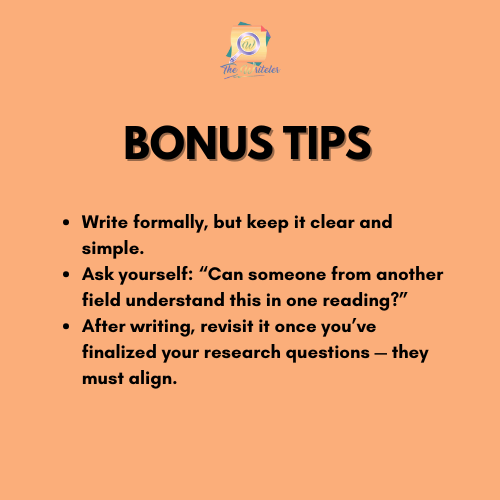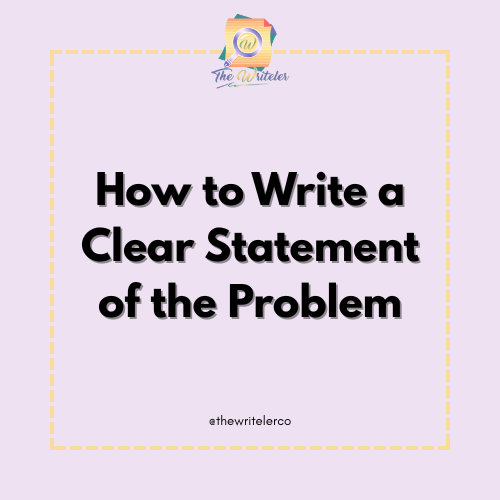Every great research paper begins with a simple question: What’s the problem you’re trying to solve?
That question is at the heart of your Statement of the Problem — one of the most critical parts of your study. It sets the stage, defines your direction, and convinces your reader (or panel) that your research is worth doing.
But let’s face it — many students struggle to write this section. Some are too vague, others too technical, and many miss the mark entirely by turning it into a rant instead of a research-driven explanation.
Don’t worry. In this guide, we’ll walk you through exactly how to write a clear, impactful, and academically sound Statement of the Problem, whether you’re doing a thesis, capstone, dissertation, or a business research report.
I. What is a Statement of the Problem?
A Statement of the Problem is a concise section (usually in Chapter 1 of your research paper) that:
- Defines the core issue your study will address,
- Provides context as to why this issue exists,
- And justifies why it needs to be solved.
It’s different from just talking about a general topic. For example:
❌ “Many students struggle with online learning.” → too vague.
✅ “Despite the rapid implementation of online learning platforms in rural public schools in the Philippines, dropout rates have increased by 35% from 2020 to 2022. This study explores the contributing factors to this rise in dropout rates.”
The second version is specific, measurable, and researchable.
II. Elements of a Strong Problem Statement
To write an effective problem statement, include these key components:
- Background Context
- What’s happening in the broader field?
- Where is this problem taking place (setting, institution, industry)?
- Specific Issue or Gap
- What is the exact problem?
- What has not been solved or addressed?
- Evidence
- Cite data, past research, or observed trends that support your claim.
- Impact
- What happens if this issue isn’t addressed?
- Who is affected?
- Scope
- Limit your focus so your study remains realistic and doable.
III. Step-by-Step Guide to Writing Your Problem Statement
Step 1: Begin With Context
Open with a few sentences that introduce the general area of concern. Keep it grounded in facts or observations.
Example:
“Online education has become a primary mode of learning in the wake of the COVID-19 pandemic, especially in Southeast Asia.”
Step 2: Narrow It Down
Zoom in on the specific issue that hasn’t been resolved.
Example:
“However, students in remote barangays in Rizal Province continue to face major challenges in accessing stable internet, attending virtual classes, and receiving adequate academic support.”
Step 3: Provide Evidence
Show data or findings that support your claim.
Example:
“According to DepEd Region IV-A, over 42% of students in rural areas did not complete the school year in 2021 due to lack of digital access.”
Step 4: Explain the Impact
What’s at stake? Why does this matter?
Example:
“If unaddressed, these issues could widen the education gap and lead to long-term academic inequality for students in these areas.”
Step 5: Lead Toward Your Study Objectives
End your paragraph by setting up your research purpose. The reader should feel like your study is a logical next step.
Example:
“This study aims to identify the key factors affecting online learning participation in rural Rizal and recommend policy interventions for improving educational delivery.”
IV. Common Mistakes to Avoid
🚫 Too Broad:
Don’t try to solve world hunger in one paper. Focus on something specific and manageable.
🚫 Too Emotional:
Avoid phrasing like “this is a tragic problem” or “this issue is very bad.” Use objective, research-backed language.
🚫 Disconnected from Objectives:
Make sure the problem statement flows naturally into your research questions and goals.
🚫 No Evidence:
Even a short paragraph can include stats or citations. Back it up.
V. Real-Life Example
Let’s say you’re studying employee productivity in hybrid work environments. Here’s a sample problem statement:
“As more companies in Metro Manila adopt hybrid work arrangements, there is growing concern about employee productivity and engagement. A 2023 study by the Institute for Labor Productivity found that 58% of hybrid workers report decreased motivation after three months of implementation. However, there remains limited research on how team communication tools influence this outcome. This study aims to explore the relationship between digital communication strategies and productivity among hybrid teams in medium-sized tech companies in Makati.”
Notice how it covers context, evidence, a gap, and a clear transition into the research goal.

📣 Need Help? The Writeler Co. is Here for You.
The Writeler Co. is here to support students and professionals who are juggling research with work, life, and business. Whether you’re writing a thesis, capstone, or dissertation for your master’s or Ph.D., we help you efficiently navigate the research journey — from brainstorming to proofreading.
📩 Message us today to get started.
📚 Let’s turn your research idea into a powerful paper.





0 Comments